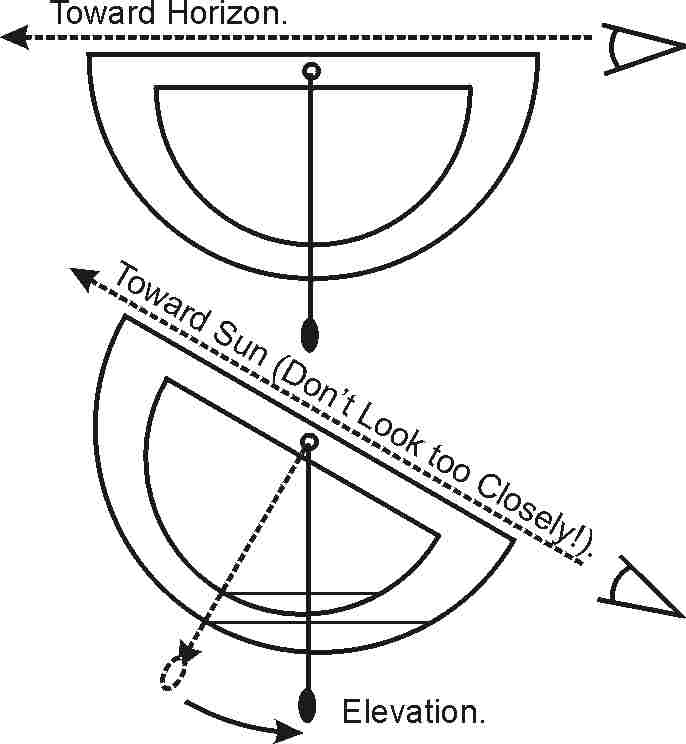Everyone can be a backyard astronomer, and for this course you will discover some basic principles of the motion of objects in the sky. To do this you will need 4 things.
1) A
place to stand somewhere with a clear view South (i.e. with your back to
Lake Mendota) and West (to your Right when looking South).
2)
A Pen and Paper.
3)
A Protractor and String.
4)
Time....
Here's the project. You are going to measure the Sun's Elevation at Noon, and the location and time when it sets on different nights (perhaps 1-2 times/week). Don't worry about covering Spring Break or if it is cloudy all week at some point. The idea is to get a measurement every so often, and to see what is happening.
1) To measure the Sun's Elevation: Looking South you are staring at your local Meridian. When it's noon the Sun will be close to the Meridian and at it's highest elevation for the day. You don't HAVE to do this right at noon; in fact noon here is not actually when the Sun crosses the Meridian-why is that do you think?
To measure that elevation, use your protractor. How? By tying a weight to a string and hanging it from the flat edge.
Align the edge to your horizon and pointing away from your eye. Then tilt it upward until it hits the Sun (don't look too closely!). The string will still point down, but it's location on the protractor will have the elevation information.
SEE ALTERNATE METHOD BELOW

An
important tip! Since looking at the Sun directly is a good way to
go blind, try blocking it by putting a penny or nickel at the end of your
protractor! Your answer won't be quite as accurate, but you'll see
better.....
Alternate method: Tape a pencil or other cylindrical object to the top edge of the protractor. Look at the shadow of the pencil and tilt the protractor until the shadow of the pencil is the smallest. Your protractor will then be lined up with the Sun (recall lecture demonstration).
2) To Measure where and when the Sun Sets: To do this one you must look West at a time near sunset. It is extremely important that you stand in the same location each night (why is that?). Make a map of the things you see on your horizon, being careful to mark their angular separations (you need a scale right?).
Each night you do this (1-2 times/week), you should put down where you saw the Sun set on your map and label it with the time. It should look something like this.

Now, we can all just look up the Sunset time in the newspaper, right? Don't DO this! No one expects you to get it just right, and we'll be suspicious of anyone who does. Accuracy is not the idea, the goal is to show you that the Sun will actually move a lot over the course of this semester.
A helpful hint. Don't forget about Daylight Savings Time! We will 'Spring Forward', and when we do the Sun will suddenly set 1 hour later. Of course this isn't a real effect, so adjust your results accordingly!
Your results should take the form of a 6 (don't worry it's not that much) page report.
1 Page (typewritten)
describing the project, what you expect to see, and why.
1 Page with a table of
the times, dates and angles for the Sun on the horizon at sunset.
1 Page with a plot of
the Sun's angle on the horizon with date.
1 Page with a table of
the times, dates, and angle of the Sun at noon on the horizon.
1 Page with a plot of
this angle with date.
1 Page (typewritten)
summarizing your results, how they fit with predictions, and what (if any)
problems you may have had. If you are different from predictions,
then comment on why you think you obtained a different result.
That's it!